We have the ecosystem group seminar at the first and third Thursday regularly for an exchange of information and views on research subject, and are publishing the abstract and part of slides used in the seminar on our website.
Schedule
* The schedule is subject to change if we have a guest speaker.
| Date | Place | Speakers | ||
|---|---|---|---|---|
| Nov 30, 2018 | Yokohama (YES) | 【Guest Seminar】 Onur Kerimoglu (Helmholtz-Zentrum Geesthacht) |
||
| Nov 2, 2018 | Yokohama (YES) | 【Guest Seminar】 George L. Hunt, Jr. (Univ. of Washington) |
||
| Oct 26, 2018 | Yokosuka (HQ) | 【Guest Seminar】 Chih-hao Hsieh (Institute of Oceanography, National Taiwan University, Taiwan) |
||
| June 22, 2018 | Yokosuka (HQ) | Yoshikazu Sasai | S. Lan Smith | |
| May 18, 2018 | Yokosuka (HQ) | Minoru Kitamura | Siri Ofstad | |
| Apr 27, 2018 | Yokosuka (HQ) | Eko Siswanto | Kana Nagashima | |
Nov. 30, 2018
Onur Kerimoglu (Helmholtz-Zentrum Geesthacht)
"Representation of plankton in a 3-D coupled physical-biogeochemical modelling framework"
Abstract
Increasing volume and intensity of antrophogenic activities result in alteration of environmental conditions at ever-increasing rates. Coupled physical-biogeochemical models are among the useful tools for understanding and predicting the response of ecosystems to these changes. However, in such model frameworks, flexibility and adaptive capacities inherent at various organismal scales are often underrepresented. In this talk, I will present my recent work on integration of an adaptive phytoplankton growth model in a coupled 3-D physical-biogeochemical framework for modelling the southern North Sea. The model is defined on a relatively high resolution (1.5-4km) curvilinear grid and terrain-following vertical coordinates for a realistic representation of the hydrodynamical processes driven by a complex, shallow (<50m) bathymetry, tidal currents and thermohaline stratification. A decadal simulation for the period 2000-2010 obtained with the model system was compared with a rich data set, consisting of semi-continuous data streams collected by Scanfish and Ferrybox platforms, sparse in-situ measurements, satellite images and measurements obtained at fixed monitoring stations. This extensive model performance assessment suggests that the characteristic features of the system, such as the steep cross-shore gradients and thin chlorophyll layers at the thermocline. Our findings point to the relevance of acclimation and stoichiometry of phytoplankton to their resource environment, but they are subject to uncertainties due to the oversimplified representation of the plankton food web, improvement of which is in progress. In closure, I will discuss the benefits of a modular approach for describing the plankton food webs, structure and complexity of which may depend on the study site and question at hand.
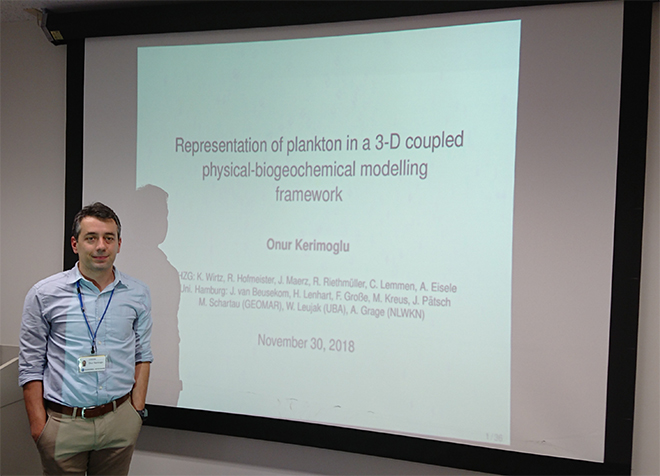
Nov 2, 2018
George L. Hunt, Jr. (Univ. of Washington)
"Physics, Fronts and Flotsam: How Seabirds Encounter Plastics"
Abstract
Plastic debris has become ubiquitous in the World Ocean. Depending on its density, it either floats at the surface or is distributed through the water column. Plastics in the ocean come in all sizes, from that of almost intact fishing nets to micro-particles a few nanometers long. Floating plastics interact with marine organisms in different ways, depending on their size of the plastic pieces. Large pieces tend to entangle organisms, while smaller pieces are ingested. Microplastics are ingested primarily filter-feeding organisms. Seabirds primarily encounter floating plastic particles when they are concentrated by down welling at converges. These convergences can be a large (ocean gyres) or small spatial scales (Langmuir Circulation cells). Ingested plastics can cause seabird starvation by filling stomachs with indigestible material. Microplastics can adsorb persistent organic pollutants, and may be passed through the food web when filter feeders are taken as prey by other species.
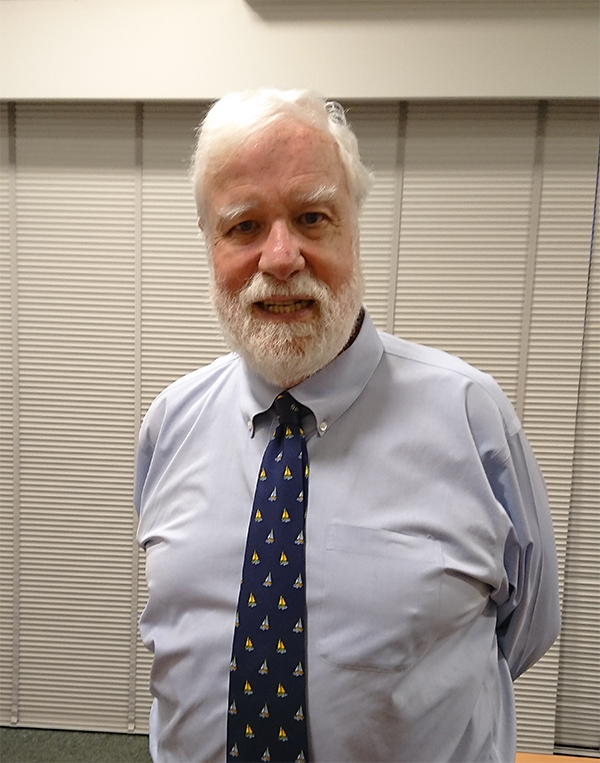
Oct 26, 2018
Chih-hao Hsieh (Institute of Oceanography, National Taiwan
University, Taiwan)
"Predator and prey biodiversity relationship and its consequences on
marine ecosystem functioning-Interplay between nanoflagellates and
bacterioplankton"
Abstract
The importance of biodiversity effects on ecosystem functioning across trophic levels, especially via predatory-prey interactions, is receiving increased recognition. However, this topic has rarely been explored for marine microbes, even though microbial biodiversity contributes significantly to marine ecosystem function and energy flows. Here, we examined diversity and biomass of bacteria (prey) and nanoflagellates (predators), as well as their effects on trophic transfer efficiency in the
East China Sea. Specifically, we investigated: (i) predator diversity effects on prey biomass and trophic transfer efficiency (using the biomass ratio of predator/prey as a proxy), (ii) prey diversity effects on predator biomass and trophic transfer efficiency, and (iii) the relationship between
predator and prey diversity. We found higher prey diversity enhanced both diversity and biomass of predators as well as trophic transfer efficiency, which may arise from more balanced diet and/or enhanced niche complementarity owing to higher prey diversity. By contrast, no clear effect
was detected for predator diversity on prey biomass and transfer efficiency.
Notably, we found prey diversity effects on predator-prey interactions, whereas, we found no significant diversity effect on biomass within the same trophic level. Our findings highlight the importance of considering multi-trophic biodiversity effects on ecosystem functioning in natural
ecosystems.
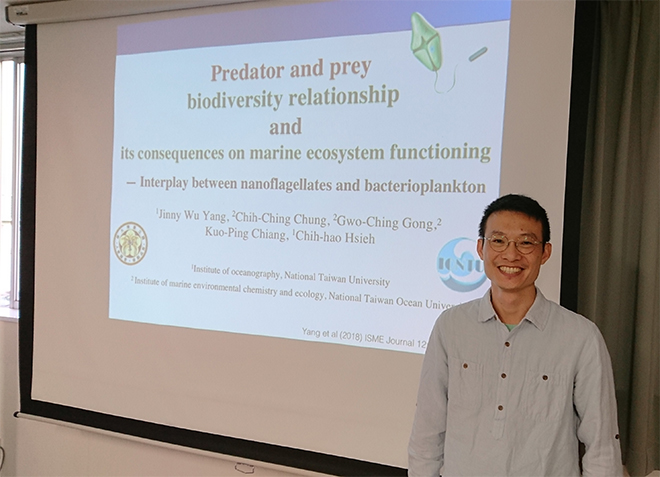
June 22, 2018
Yoshikazu Sasai
"Impact of ocean physics on marine ecosystems in the Kuroshio and Kuroshio Extension regions: A high-resolution coupled physical-biological model study"
Abstract
A high-resolution coupled physical-biological ocean model is applied to investigate the physical transport of nutrients and the maintenance of biological production in the Kuroshio and Kuroshio Extension (KE) regions. The model captures the Kuroshio nutrient transport over the North Pacific, and the seasonal and intra-seasonal variability of biogeochemical distributions are associated with mesoscale eddies, fronts, flow filaments, Kuroshio meanders, convection, and upwelling/downwelling. The model also reproduces the observed inter-annual variability of sea surface height anomaly (SSHA) in the KE region from 2000 to 2012. The distributions of high (low) nitrate and phytoplankton concentrations correspond to negative (positive) SSHA. In terms of nutrient supply, the cyclonic eddies passing through the Kuroshio Extension Observatory station in the subtropical region cause upwelling. These events lift nutrient-rich water into the euphotic zone and increase subsurface biological production during summer and fall. One eddy that was tracked from May to July 2004 off the east of Taiwan, contributed to the greatest vertical nutrient flux and enhancement of biological production.
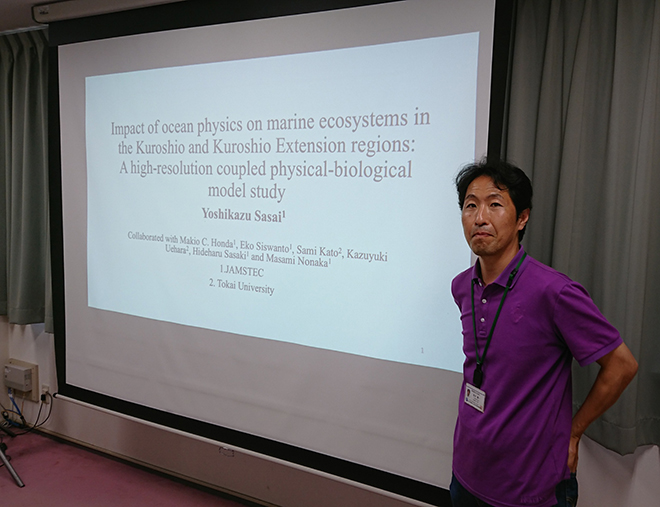
S. Lan Smith
"Can we go Off the Grid? --at least for Plankton Ecosystem Modeling"
Abstract
Spatially explicit models, such as the 3-D models run on the Earth Simulator, are typically based on discrete approximations assuming homogeneity within each grid cell. This means that the concentrations of nutrients and organisms, and the environmental conditions that determine their response, are treated as uniform on scales of kilometers (in 3-D models) or perhaps at scales down to meters in vertical 1-D models. Many such models incorporate some representation of plankton, because they are the sustaining base of marine food webs, including ultimately fisheries, and also drive important biogeochemical cycles of nutrients and carbon, which have potentially important feedbacks with climate. However, plankton range in size from micrometers to at most centimeters and therefore experience heterogeneity and intermittency at far smaller scales than such model grids. Recent observations and modeling studies have revealed that sub-grid scale distributions of plankton biomass are more important to ecosystem dynamics than are the mean-field concentrations represented in typical models. I will briefly present two recent modeling approaches that go beyond grid-based approaches by accounting for: 1) the statistical distribution of mm-scale aggregates of phytoplankton and associated intermittency in nutrients and zooplankton, and 2) the active and strategically important motion of plankton that is still largely ignored in ecosystem models. Each of these approaches gives results substantially different from typical gridded models. How can we work together to overcome the remaining challenges and implement these more realistic off-the-grid approaches in spatially explicit models?
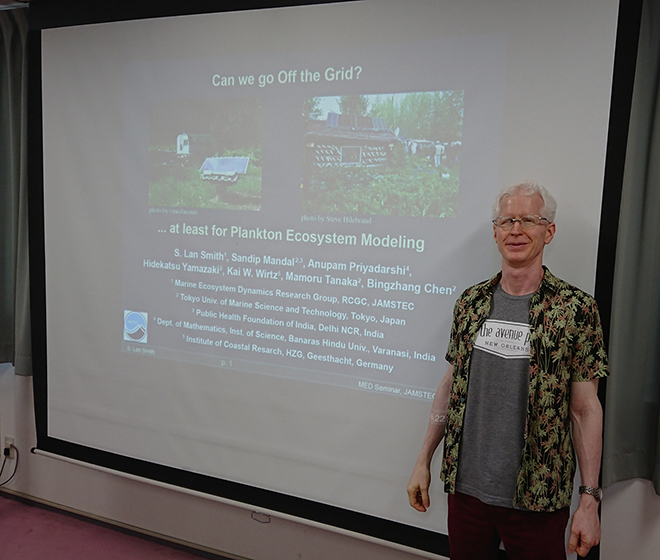
May 18, 2018
Minoru Kitamura
"Ontogenetic change and horizontal variability of foraminiferan shell density; preliminary report"
Abstract
By using the historical CPR sample set and MXCT, we have a plan to research biological response of foraminifera to ocean acidification. In the first place, can we use foraminifera specimens collected by using CPR for this study? I will talk about potential risk of this study. Although shell density of foraminifera is probably useful as a proxy to understand presence or absence of their biological response to OA, calcification processes of foraminiferan shell are still poorly known. So, we are investigating (1) ontogenetic change of shell density, and (2) horizontal variability of shell density to understand environmental parameters which influence shell density other than OA. In this seminar, I will talk about preliminary results of these investigations.
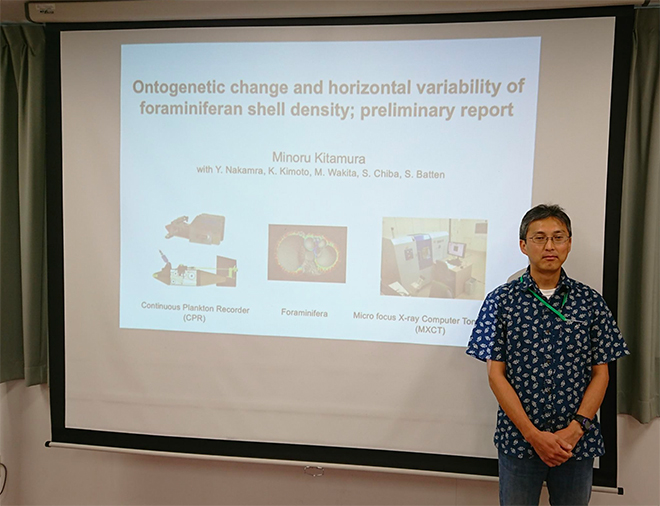
Siri Ofstad
"MXCT study of planktic foraminifera from the Barents Sea – A comparison between marine carbonate chemistry paleo-proxies"
Abstract
Size-normalised weight (SNW), area density and bulk density are utilized as paleo-proxies for marine carbonate chemistry. These paleo-proxy data were generated by measuring and weighing individual Turborotalita quinqueloba and Neogloboquadrina pachyderma specimen from plankton net samples from a methane seepage site in the Central Barents Sea. Because N. pachyderma exhibit high phenotypic plasticity, they were categorized into their morphotypes (Nps 1-6). To assess whether or not SNW, area density and bulk density are reliable proxies for calcite density, the same specimen were scanned by a Micro-Focus X-ray Computing Tomography (MXCT). The MXCT measures calcite density, in addition to providing high precision morphometrics. It is a new robust method which can be used to quantitatively evaluate the impact of ocean acidification on marine calcifiers. Shell weight and calcite density showed a weak positive relationship, while bulk density and calcite density showed no correlation. N. pachyderma displayed varying shell thickness and density corresponding to morphotypes, this is potentially due to differing modes of life. In addition, data were compared to the carbonate system parameters in the water column. Calcite density and DIC showed a strong positive relationship, supporting claims that calcification strength is coupled with DIC. Shell weight and DIC also have a positive relationship, however it is weaker. In conclusion, MXCT data has a higher correlation to carbonate system parameters and is a superior method when assessing the effects of ocean acidification on planktic foraminifers.
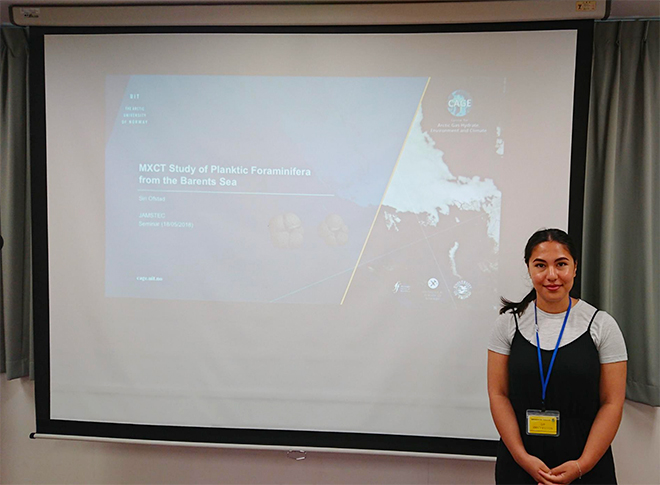
Apr 27, 2018
Eko Siswanto
"A rare dispersion of low-salinity, high-gelbstoff, high-primary production water in the East China Sea during the summer of 2010"
Abstract
A rare dispersion of Changjiang-influenced water (CIW) in the East China Sea in summer 2010 was observed. The CIW obviously dispersed southeastward and intruded into the Kuroshio Current axis to form a rare band of CIW that flowed toward an area south of Japan. Such a rare dispersion was attributed primarily to alongshore wind anomaly and secondarily to the Changjiang discharge which linked to El Nino/Southern Oscillation variability. Based on ocean color and Argo float dataset, it was confirmed that the CIW was characterized by low salinity, high gelbstoff, and high primary production.
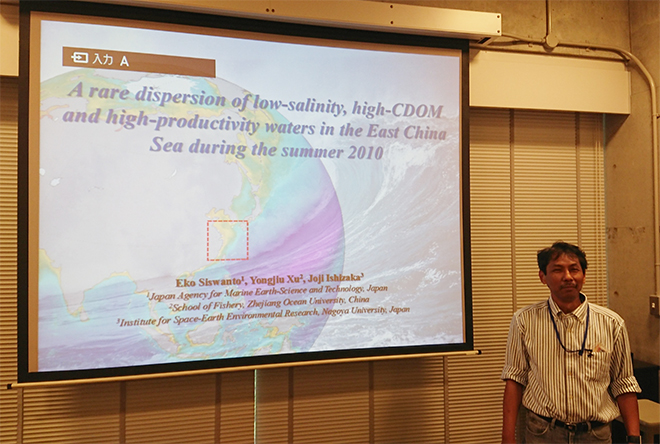
Kana Nagashima
"What controls multi-centennial scale Aleutian Low variation?"
Abstract
Increasing evidences show that Aleutian Low (AL) intensity varies on the multi-centennial scale and affects marine productivity in the Alaska current region (e.g., Anderson et al., 2005). However, the spatial extent of the atmospheric circulation changes and ultimate cause of the AL variation are not systematically understood. Here I exhibit synchronous variations in the Aleutian Low intensity and the westerly jet path in the mid-to-high northern/southern latitudes using the compiled proxy records, suggesting large horizontal and vertical extent of the multi-centennial scale atmospheric circulation changes. The periods characterized by the Aleutian Low minima and the northward (southward) shifts of the westerly jet path in the northern (southern) hemisphere mostly correspond to the periods with strong solar activity. Such synchronicity suggests that the multi-centennial scale atmospheric circulation changes recorded in multi-proxies were invoked by solar activity change probably through top (stratosphere) to down (troposphere) penetration of the solar effects.
